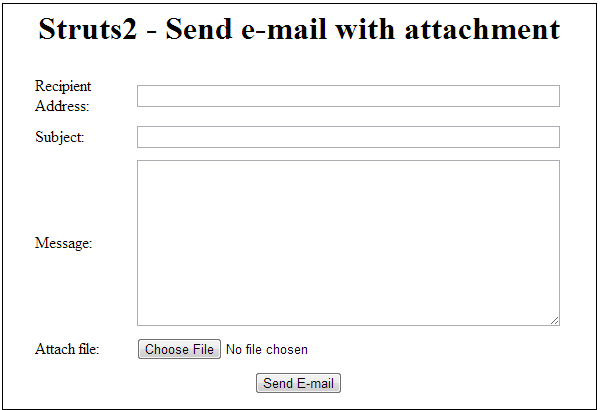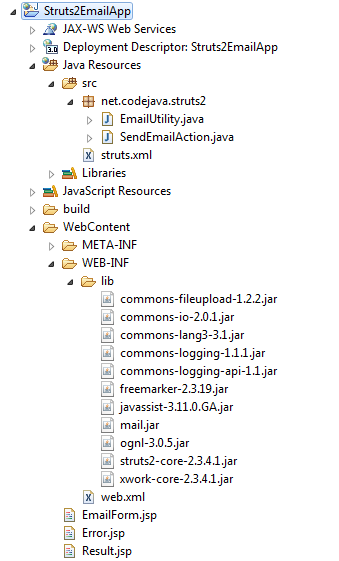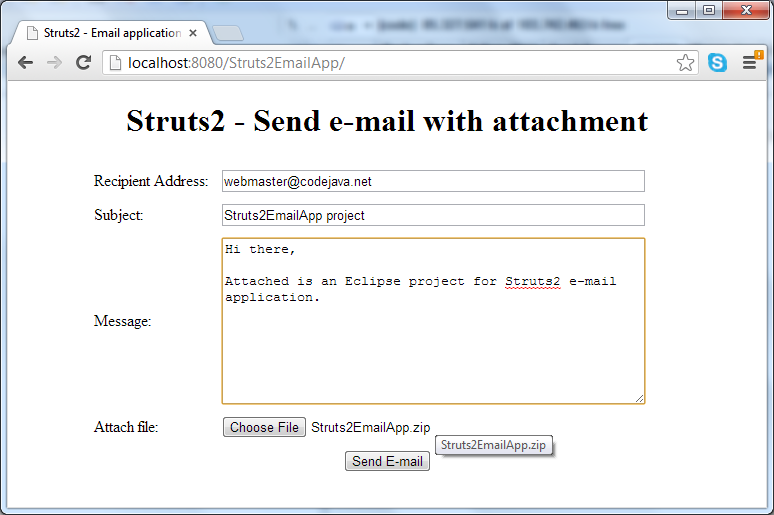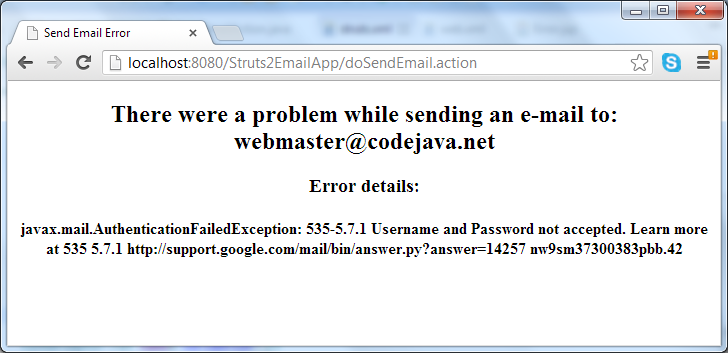Struts Send E-mail with Attachments Tutorial
- Details
- Written by Nam Ha Minh
- Last Updated on 31 July 2019 | Print Email
 Currently, there is no plug-in for e-mailing in Struts, so the preferred choice is using JavaMail directly in Struts action class. Technically, the solution for this application is combination of two technologies:
Currently, there is no plug-in for e-mailing in Struts, so the preferred choice is using JavaMail directly in Struts action class. Technically, the solution for this application is combination of two technologies:- File upload: using Struts interceptor called fileUpload.
- E-mail sending with attachment: using JavaMail API.
- EmailUtility.java: is a utility class for sending e-mail.
- SendEmailAction.java: a Struts action class.
- EmailForm.jsp: shows the e-mail form.
- Result.jsp: shows successful message after the e-mail was sent.
- Error.jsp: shows error message in case of exception thrown.
- struts.xml: Struts configuration file.
- web.xml: web deployment descriptor file.
1. Required Jar files for Struts and JavaMail
The following table lists all the jar files required for the application:
Jar files come with Struts2 distribution | commons-fileupload-1.2.2.jar |
commons-io-2.0.1.jar | |
commons-lang3-3.1.jar | |
commons-logging-1.1.1.jar | |
commons-logging-api-1.1.jar | |
freemarker-2.3.19.jar | |
javassist-3.11.0.GA.jar | |
ognl-3.0.5.jar | |
struts2-core-2.3.4.1.jar | |
xwork-core-2.3.4.1.jar | |
Jar file come with JavaMail distribution | mail.jar |

2. Code Java E-mail utility class
Create a Java file called EmailUtility.javawith the following code:package net.codejava.struts2;
import java.io.File;
import java.io.IOException;
import java.util.Date;
import java.util.Properties;
import javax.mail.Authenticator;
import javax.mail.Message;
import javax.mail.MessagingException;
import javax.mail.Multipart;
import javax.mail.PasswordAuthentication;
import javax.mail.Session;
import javax.mail.Transport;
import javax.mail.internet.AddressException;
import javax.mail.internet.InternetAddress;
import javax.mail.internet.MimeBodyPart;
import javax.mail.internet.MimeMessage;
import javax.mail.internet.MimeMultipart;
/**
* A utility class for sending e-mail with attachment.
* @author www.codejava.net
*
*/
public class EmailUtility {
public static void sendEmail(String host, String port,
final String userName, final String password,
String recipient, String subject, String message, File attachFile)
throws AddressException, MessagingException {
// sets SMTP server properties
Properties properties = new Properties();
properties.put("mail.smtp.host", host);
properties.put("mail.smtp.port", port);
properties.put("mail.smtp.auth", "true");
properties.put("mail.smtp.starttls.enable", "true");
properties.put("mail.user", userName);
properties.put("mail.password", password);
// creates a new session with an authenticator
Authenticator auth = new Authenticator() {
public PasswordAuthentication getPasswordAuthentication() {
return new PasswordAuthentication(userName, password);
}
};
Session session = Session.getInstance(properties, auth);
// creates a new e-mail message
Message msg = new MimeMessage(session);
msg.setFrom(new InternetAddress(userName));
InternetAddress[] toAddresses = { new InternetAddress(recipient) };
msg.setRecipients(Message.RecipientType.TO, toAddresses);
msg.setSubject(subject);
msg.setSentDate(new Date());
// creates message part
MimeBodyPart messageBodyPart = new MimeBodyPart();
messageBodyPart.setContent(message, "text/html");
// creates multi-part
Multipart multipart = new MimeMultipart();
multipart.addBodyPart(messageBodyPart);
// adds attachments
if (attachFile != null) {
MimeBodyPart attachPart = new MimeBodyPart();
try {
attachPart.attachFile(attachFile);
} catch (IOException ex) {
ex.printStackTrace();
}
multipart.addBodyPart(attachPart);
}
// sets the multi-part as e-mail's content
msg.setContent(multipart);
// sends the e-mail
Transport.send(msg);
}
}This utility class has only one static method sendEmail() that sends an e-mail from a SMTP server. It has the following parameters:- SMTP settings: host, port, userName and password.
- E-mail information: recipient, subject, message and attachFile.
3. Code Send E-mail form (JSP)
Create a JSP file called EmailForm.jsp with the following code:<%@ page language="java" contentType="text/html; charset=UTF-8"
pageEncoding="UTF-8"%>
<%@ taglib prefix="s" uri="/struts-tags" %>
<!DOCTYPE html PUBLIC "-//W3C//DTD HTML 4.01 Transitional//EN"
"http://www.w3.org/TR/html4/loose.dtd">
<html>
<head>
<meta http-equiv="Content-Type" content="text/html; charset=UTF-8">
<title>Struts2 - Email application</title>
</head>
<body>
<center>
<h1>Struts2 - Send e-mail with attachment</h1>
<s:form action="doSendEmail" enctype="multipart/form-data" method="post">
<table border="0" width="80%" align="center">
<tr>
<td>
<s:textfield name="recipient" size="65" label="Recipient Address" />
</td>
</tr>
<tr>
<td>
<s:textfield name="subject" size="65" label="Subject" />
</td>
</tr>
<tr>
<td>
<s:textarea cols="50" rows="10" name="message" label="Message" />
</td>
</tr>
<tr>
<td>
<s:file name="fileUpload" size="60" label="Attach file" />
</td>
</tr>
<tr>
<td>
<s:submit value="Send E-mail" align="center" />
</td>
</tr>
</table>
</s:form>
</center>
</body>
</html>We use Struts tags to create the form elements. Note that the form must have following attributes:- enctype="multipart/form-data": specifies that the form may contain file upload.
- method="post": indicates that the form will be submitted by HTTP POST method.
- action="doSendEmail": specifies name of the action which will handle submission of this form. We will configure Struts to handle this action.
4. Code Struts action class
Create a Java file called SendEmailAction.java to represent a Struts action class, with the following code:package net.codejava.struts2;
import java.io.File;
import java.io.IOException;
import javax.mail.MessagingException;
import javax.mail.internet.AddressException;
import org.apache.commons.io.FileUtils;
public class SendEmailAction {
// SMTP properties - fetched from struts.xml
private String host;
private String port;
private String userName;
private String password;
// file upload properties - fetched by interceptor fileUpload
private File fileUpload;
private String fileUploadFileName;
private String fileUploadContentType;
// e-mail fields - fetched from EmailForm.jsp
private String recipient;
private String subject;
private String message;
public String doSendEmail() throws IOException, AddressException,
MessagingException {
File saveFile = null;
String tempPath = System.getProperty("java.io.tmpdir");
saveFile = new File(tempPath + File.separator + fileUploadFileName);
FileUtils.copyFile(fileUpload, saveFile);
EmailUtility.sendEmail(host, port, userName, password, recipient,
subject, message, saveFile);
if (saveFile != null) {
saveFile.delete();
}
return "success";
}
public String getHost() {
return host;
}
public void setHost(String host) {
this.host = host;
}
public String getPort() {
return port;
}
public void setPort(String port) {
this.port = port;
}
public String getUserName() {
return userName;
}
public void setUserName(String userName) {
this.userName = userName;
}
public String getPassword() {
return password;
}
public void setPassword(String password) {
this.password = password;
}
public File getFileUpload() {
return fileUpload;
}
public void setFileUpload(File fileUpload) {
this.fileUpload = fileUpload;
}
public String getFileUploadFileName() {
return fileUploadFileName;
}
public void setFileUploadFileName(String fileUploadFileName) {
this.fileUploadFileName = fileUploadFileName;
}
public String getFileUploadContentType() {
return fileUploadContentType;
}
public void setFileUploadContentType(String fileUploadContentType) {
this.fileUploadContentType = fileUploadContentType;
}
public String getRecipient() {
return recipient;
}
public void setRecipient(String recipient) {
this.recipient = recipient;
}
public String getSubject() {
return subject;
}
public void setSubject(String subject) {
this.subject = subject;
}
public String getMessage() {
return message;
}
public void setMessage(String message) {
this.message = message;
}
}In this action class, we declared JavaBean-style properties for:- SMTP settings: are used by the EmailUtility class. These properties are fetched by Struts interceptor staticParams from struts.xml file.
- File upload properties: are fetched by Struts interceptor fileUpload. For in-depth information about upload file with Struts, see the article: Upload file with Struts.
- E-mail fields: These properties correspond to e-mail form’s fields, so they will be fetched by Struts automatically.
5. Code other JSP views
Beside the EmailForm.jsp file, we have to create two other JSP files: Result.jsp and Error.jsp.Write code for the Result.jsp page as follows:<%@ page language="java" contentType="text/html; charset=UTF-8"
pageEncoding="UTF-8"%>
<!DOCTYPE html PUBLIC "-//W3C//DTD HTML 4.01 Transitional//EN"
"http://www.w3.org/TR/html4/loose.dtd">
<html>
<head>
<meta http-equiv="Content-Type" content="text/html; charset=UTF-8">
<title>Send Email Result</title>
</head>
<body>
<center>
<h2>The email was sent successfully!</h2>
</center>
</body>
</html>This result page will be displayed in case the e-mail was sent successfully.And for the Error.jsp page as follows:<%@ page language="java" contentType="text/html; charset=UTF-8"
pageEncoding="UTF-8"%>
<%@ taglib prefix="s" uri="/struts-tags" %>
<!DOCTYPE html PUBLIC "-//W3C//DTD HTML 4.01 Transitional//EN"
"http://www.w3.org/TR/html4/loose.dtd">
<html>
<head>
<meta http-equiv="Content-Type" content="text/html; charset=UTF-8">
<title>Send Email Error</title>
</head>
<body>
<center>
<h2>There were a problem while sending an e-mail to: <s:property value="recipient"/></h2>
<h3>Error details:</h3>
<h4><s:property value="exception" /></h4>
</center>
</body>
</html>This error page is only displayed in case an error occurred. 6. Configure struts.xml
Create Struts configuration file called struts.xml with the following XML code:<?xml version="1.0" encoding="UTF-8"?>
<!DOCTYPE struts PUBLIC
"-//Apache Software Foundation//DTD Struts Configuration 2.0//EN"
"http://struts.apache.org/dtds/struts-2.0.dtd">
<struts>
<constant name="struts.multipart.maxSize" value="10485760" /> <!-- 10 MB -->
<package name="Struts2Email" extends="struts-default">
<global-results>
<result name="error">/Error.jsp</result>
</global-results>
<global-exception-mappings>
<exception-mapping exception="java.lang.Exception"
result="error" />
</global-exception-mappings>
<action name="doSendEmail" class="net.codejava.struts2.SendEmailAction"
method="sendEmail">
<!-- SMTP configuration -->
<param name="host">smtp.gmail.com</param>
<param name="port">587</param>
<param name="userName">youremail</param>
<param name="password">yourpassword</param>
<!-- End of SMTP configuration -->
<interceptor-ref name="fileUpload">
<param name="allowedTypes">*/*</param> <!-- all file types -->
<param name="maximumSize">4194304</param> <!-- 4 MB -->
</interceptor-ref>
<interceptor-ref name="staticParams"/>
<interceptor-ref name="params"/>
<interceptor-ref name="validation" />
<interceptor-ref name="workflow" />
<interceptor-ref name="exception"/>
<result name="success" type="redirect">/Result.jsp</result>
<result name="input">/EmailForm.jsp</result>
</action>
</package>
</struts>Firstly, we restrict size of a multipart request up to 10MB at the beginning of the configuration.Secondly, we configure exception mapping of exception type java.lang.Exception to a view named error (which maps to the error page).In the action configuration, we declare a Struts action with the following attributes:- name="doSendEmail": this name must match with the action attribute of the e-mail form in the EmailForm.jsp file.
- method="sendEmail": this name must match with the action method declared in the action class SendEmailAction.
- class="net.codejava.struts2.SendEmailAction": specifies implementation class for a the action.
- Parameters for SMTP settings: in this case, the settings are configured for SMTP of a GMail account. Remember to update these settings to match with your e-mail account.
- Interceptor fileUpload: this interceptor is responsible for parsing multipart request and makes the upload file available as simple as a property in the action class. We also configure the allowed file types for all types and maximum size of an upload file is 4MB.
- Other interceptors: staticParams, params, validation, workflow and exception - these interceptors are necessary to fetch SMTP settings into the action class; are helpers of the fileUpload interceptor. The exception interceptor redirects uncaught exceptions to the specified error page.
- Two result tags: specify input page and success page for the action.
7. Configure web.xml
Configure the web deployment descriptor file as follows:<?xml version="1.0" encoding="UTF-8"?>
<web-app xmlns:xsi="http://www.w3.org/2001/XMLSchema-instance"
xmlns="http://java.sun.com/xml/ns/javaee"
xmlns:web="http://java.sun.com/xml/ns/javaee/web-app_2_5.xsd"
xsi:schemaLocation="http://java.sun.com/xml/ns/javaee
http://java.sun.com/xml/ns/javaee/web-app_3_0.xsd"
id="WebApp_ID" version="3.0">
<display-name>Struts2EmailApp</display-name>
<welcome-file-list>
<welcome-file>EmailForm.jsp</welcome-file>
</welcome-file-list>
<filter>
<filter-name>struts2</filter-name>
<filter-class>
org.apache.struts2.dispatcher.ng.filter.StrutsPrepareAndExecuteFilter
</filter-class>
</filter>
<filter-mapping>
<filter-name>struts2</filter-name>
<url-pattern>/*</url-pattern>
</filter-mapping>
</web-app>This configuration simply declares the Struts dispatcher filter to intercept all requests coming to the application, and declares the EmailForm.jsp as the default page when accessing the application. 8. Test the Struts Send E-mail application
Deploy the application on Tomcat and type the following URL into web browser’s address bar:http://localhost:8080/Struts2EmailApp
The e-mail form appears, enter required information and pick up a file to attach to the e-mail, for example: If everything went well, a successful message appears:
If everything went well, a successful message appears: In case an exception is thrown (such as invalid username/password of the SMTP settings), the error page will show up:
In case an exception is thrown (such as invalid username/password of the SMTP settings), the error page will show up:
Related Tutorials:
Other Struts Tutorials:
- Introduction to Struts 2 framework
- Struts beginner tutorial (Eclipse + Tomcat + XML)
- Struts Beginner Tutorial with Annotations
- Struts beginner tutorial with Convention Plugin (zero-configuration)
- How to handle exceptions in Struts
- Struts File Download Tutorial
- Struts File Upload Tutorial
- Struts - Spring - Hibernate Integration Tutorial
About the Author:
 Nam Ha Minh is certified Java programmer (SCJP and SCWCD). He began programming with Java back in the days of Java 1.4 and has been passionate about it ever since. You can connect with him on Facebook and watch his Java videos on YouTube.
Nam Ha Minh is certified Java programmer (SCJP and SCWCD). He began programming with Java back in the days of Java 1.4 and has been passionate about it ever since. You can connect with him on Facebook and watch his Java videos on YouTube.
Comments
go to your account and turn on the security it will work
For Those who get error with mail authentication ie. javax.mail.AuthenticationFailedException:
i have selected image file to attach but i don't know what is the problem.
please help me...anyone